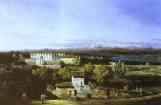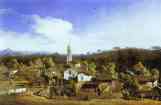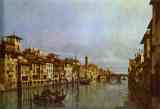Bernardo Bellotto Biography
Bernardo Bellotto, pupil and nephew of Canaletto, had a highly successful international career. Canaletto, whose name Bellotto sometimes illegally adopted, especially during his stay in Poland, was his uncle on his mother’s side and had trained the young artist for many years. By 1738, Bellotto was already a member of the Venician Painters’ Guild. Still under Canaletto’s guidance, the young Bellotto traveled extensively in Italy. He went to Rome, Florence, Turin, Milan and Verona. In each city he left memorable images, giving a precocious demonstration of his ability to capture not only the architectural or natural features, but also the specific quality of the light in each place he visited. View with the Villa Melzi d'Eril. View of the Gazzada.Arno in Florence. Signoria Square in Florence.
After returning briefly to Venice, in the summer of 1747, Bellotto accepted an invitation from Augustus III, the Elector of Saxony, and moved to Dresden. During the ten years the artist spent there, he produced a remarkable series of wonderful views of the city and its surroundings. He repeated these paintings for the Prime Minister, Count Brühl, who eventually sold his collection to Catherine II the Great into St. Petersburg. With the purchase of the collection, Catherine the Great bought many of Bellotto’s finest topographic works. The Old Market Square in Dresden, The New Market Square in Dresden, Pirna Seen from the Right Bank of the Elbe are not only convincing in and for themselves, but also remind us of what happened to all that beauty after Dresden was bombed to the ground in the Second World War.
Bellotto had enormous success and his reputation spread throughout the whole of Central Europe. In 1758, the Empress Maria-Teresa summoned him to Vienna, where he painted views of the capital’s Gothic and Baroque monuments.
His next stop was Munich where, from 1761, he worked for the Elector of Bavaria. After five years there Bellotto returned to Dresden. In 1764-1766, he was a teacher at the Dresden Academy.
In late 1766, he went to Warsaw. He had hoped eventually to reach St. Petersburg and work for Empress Catherine II but he stayed permanently in Warsaw at the urging of the recently crowned king, Stanislaus II Augustus Poniatowski. His views of Warsaw are nearly all collected in the city’s Royal Castle. Thanks to the fact that their poetic quality was combined with faultless accuracy, they were used as a draft for rebuilding Warsaw after its near-total destruction in the Second World War.
Bernardo Bellotto died in Warsaw in 1780.
Bibliography
Europäische Veduten des Bernardo Belotto, gennant Canaletto. Ausstellung. Essen. 1966.
The Art of the Italian Renaissance. Architecture. Sculpture. Painting. Drawing. Könemann. 1995.
Painting of Europe. XIII-XX centuries. Encyclopedic Dictionary. Moscow. Iskusstvo. 1999.
Seeing Venice: Bellotto's Grand Canal by Mark Doty, Bernardo Bellotto. J. Paul Getty Trust Publications, 2002.
Bernardo Bellotto: A Venetian Painter In Warsaw by Krysztof Pomyan, P. Mrozowski 5 Continents, 2004.
Bernardo Bellotto and the Capitals of Europe by Bernardo Bellotto, Irina Artemieva, Charles Beddington, Martina Frank, Bozena Anna Kowalczyk, Andrzej Rottermund, Gregor J. M. Weber, Edgar Peters Bowron. Yale University Press, 2001.
- View With The Villa Melzi D'Eril.

1744. Oil on canvas. Brera, Milan, Italy.
- View Of The Gazzada.

1744. Oil on canvas. Brera, Milan, Italy.
- Arno In Florence.

Early 1740s. Oil on canvas. Museum of Fine Arts, Budapest, Hungary.